NCERT Solutions for Class 10 Science Chapter 12 Magnetic Effects of Electric Current includes the latest edition answers to intext & exercise questions. All these NCERT solutions are prepared by expert teachers with detailed explanations of every important topic. It is important for the students to go through these NCERT solutions to get knowledge of the type of question asked in Magnetic Effects of Electric Current chapter.
NCERT Solutions for Class 10 Science Chapter 12 Intext Questions
Page No. 196
Question 1: Why does a compass needle get deflected when brought near a bar magnet?
Answer: Magnetic compass needle and bar magnet both have a magnetic field. When they brought near to each other, these magnetic fields interact with each other giving deflection in the needle.
OR
When a compass needle is brought near a bar magnet, it gets deflected because the magnetic field of the bar magnet interacts with the magnetic field of the compass needle. The compass needle, being a magnet itself, is normally aligned with Earth’s magnetic field, which is in the north-south direction. However, the magnetic field of the bar magnet near the compass is much stronger than Earth’s magnetic field at that location. So, the compass needle reorients itself to align with the magnetic field of the bar magnet, resulting in its deflection. This happens due to the magnetic force exerted by the bar magnet on the compass needle.
Page No. 200
Question 1: Draw magnetic field lines around a bar magnet.
Answer:
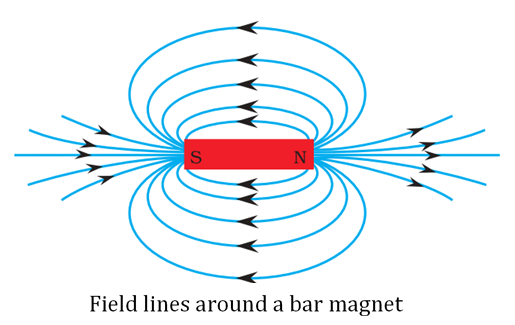
Question 2: List the properties of magnetic lines of force.
Answer: Properties of magnetic lines of force (also known as magnetic field lines) are listed below:
- Outside the magnet, the magnetic field lines are directed from N-pole of the magnet towards S-pole. However, inside a magnet the field lines are directed from S-pole to N-pole. Thus, magnetic field lines form a close loop.
- The magnetic field line at any point points in the direction of the magnetic field at that point.
- The relative strength of magnetic fields is given by the degree of closeness of the field lines. The magnetic field is strong in the region where the field lines are crowded.
- No two magnetic field lines can ever intersect with each other.
Question 3: Why don’t two magnetic lines of force intersect each other?
Answer: Two magnetic lines of force don’t intersect each other because each line represents the direction of the magnetic field at that point. If two lines were to intersect, it would imply that the magnetic field has two different directions at the same point, which is impossible.
Page No. 201
Question 1: Consider a circular loop of wire lying in the plane of the table. Let the current pass through the loop clockwise. Apply the right-hand rule to find out the direction of the magnetic field inside and outside the loop.
Answer: The magnetic field lines have been shown in Figure given below. As per right- hand rule, we find that inside the loop, the magnetic field lines are directed perpendicular to the plane of paper in the inward direction. Outside the loop, magnetic field lines are directed out of the plane of paper.
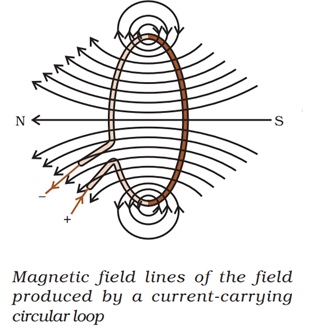
Question 2: The magnetic field in a given region is uniform. Draw a diagram to represent it.
Answer: The uniform magnetic field is represented by parallel, equidistant lines of equal length as shown in Figure.
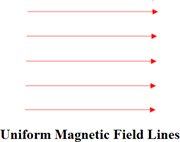
Question 3: Choose the correct option.
The magnetic field inside a long straight solenoid-carrying current
(a) is zero.
(b) decreases as we move towards its end.
(c) increases as we move towards its end.
(d) is the same at all points.
Answer: (d) is the same at all points.
Page No. 203
Question 1: Which of the following property of a proton can change while it moves freely in a magnetic field? (There may be more than one correct answer)
(a) Mass
(b) Speed
(c) Velocity
(d) Momentum
Answer: (c) Velocity and (d) Momentum
Question 2: In Activity 13.7, how do we think the displacement of rod AB will be affected if
(i) current in rod AB is increased;
(ii) a stronger horse-shoe magnet is used; and
(iii) length of the rod AB is increased?
Answer:
(i) If the current in rod AB is increased, the displacement will also increase.
(ii) If we use a stronger horse-shoe magnet then the displacement of rod AB will increase.
(iii) lf length of the rod is increased, the force acting on it will increase and, hence, displacement of the rod increases.
Question 3: A positively-charged particle (alpha-particle) projected towards west is deflected towards north by a magnetic field. The direction of magnetic field is
(a) towards south
(b) towards east
(c) downward
(d) upward
Answer: (d) upward
In accordance with Fleming’s left-hand rule, the direction of magnetic field is vertically upward.
Page No. 205
Question 1: State Fleming’s left-hand rule.
Answer: According to Fleming’s left-hand rule, stretch the thumb, forefinger and middle finger of your left hand such that they are mutually perpendicular. If the first finger points in the direction of the magnetic field and the second finger in the direction of the current, then the thumb will point in the direction of motion or the force acting on the conductor.
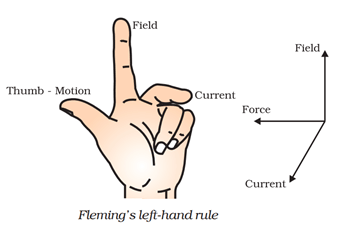
Question 2: What is the principle of an electric motor?
Answer: The working principle of an electric motor is based on the magnetic effect of current. A current-carrying loop experiences a force and rotates when placed in a magnetic field. The direction of rotation of the loop is given by Fleming’s left-hand rule.
Question 3: What is the role of the split ring in an electric motor?
Answer: The split ring in the electric motor acts as a commutator. The commutator reverses the direction of current flowing through the coil after each half rotation of the coil. Due to this reversal of the current, the coil continues to rotate in the same direction.
NCERT Solutions for Class 10 Science Chapter 12 Exercise Questions
Question 1: Which of the following correctly describes the magnetic field near a long straight wire?
(a) The field consists of straight lines perpendicular to the wire.
(b) The field consists of straight lines parallel to the wire.
(c) The field consists of radial lines originating from the wire.
(d) The field consists of concentric circles centred on the wire.
Answer: (d) The field consists of concentric circles centred on the wire.
The field consists of concentric circles centred on the wire. On applying right-hand thumb rule, we find the direction of the magnetic field. The field is in the form of concentric circles centred on the wire carrying current.
Hence, the option (d) is correct.
Question 2: At the time of short circuit, the current in the circuit
(a) reduces substantially.
(b) does not change.
(c) increases heavily.
(d) vary continuously.
Answer: (c) increases heavily.
At the time of short circuiting the live wire and the neutral wire come into direct contact. As a result, the current in the circuit abruptly increases. Hence, the option (c) is correct.
Question 3: State whether the following statements are true or false.
(a) The field at the centre of a long circular coil carrying current will be parallel straight lines.
(b) A wire with a green insulation is usually the live wire of an electric supply.
Answer:
(a) True
(b) False
Question 4: List two methods of producing of magnetic fields.
Answer: Two methods of producing magnetic field are as follows:
- Magnetic field can be produced by placing a permanent bar magnet or a horse-shoe magnet at the place, where the magnetic field is required.
- Magnetic field is produced around a current-carrying straight conductor or a current-carrying circular coil.
Question 5: When is the force experienced by a current–carrying conductor placed in a magnetic field largest?
Answer: The force experienced by a current-carrying conductor placed in a magnetic field is largest when the current-carrying conductor is placed in a direction perpendicular to that of magnetic field.
Question 6: Imagine that you are sitting in a chamber with your back to one wall. An electron beam, moving horizontally from back wall towards the front wall, is deflected by a strong magnetic field to your right side. What is the direction of magnetic field?
Answer: An electron beam moving horizontally from back wall towards the front wail is equivalent to a current flowing in the opposite direction (i.e., from front wall towards the back wall). The deflection of electron beam as seen by observer is to his right side and is shown in Figure. On applying Fleming’s left-hand rule we find that the magnetic field is acting in vertically downward direction.
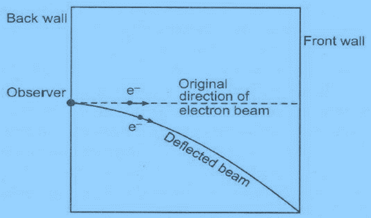
Question 7: State the rule to determine the direction of a
(i) magnetic field produced around a straight conductor-carrying current,
(ii) force experienced by a current-carrying straight conductor placed in a magnetic field which is perpendicular to it, and
(iii) current induced in a coil due to its rotation in a magnetic field.
Answer:
(i) Maxwell’s right-hand thumb rule
(ii) Fleming’s left-hand rule
(iii) Fleming’s right-hand rule
Question 8: When does an electric short circuit occur?
Answer: An electric short circuit occurs when there is a low-resistance connection between two points in an electric circuit, causing an excessive flow of current. This usually happens when either the insulation of wires used in an electrical circuit is damaged or there is a fault in the appliance, live wire and neutral wire may come in direct contact. As a result, the current in the circuit abruptly rises and short-circuiting occurs.
Question 9: What is the function of an earth wire? Why is it necessary to earth metallic appliances?
Answer: The metallic body of electric appliances is connected to the earth by means of earth wire so that any leakage of electric current is transferred to the ground. This prevents any electric shock to the user. That is why earthing of the electrical appliances is necessary.
OR
The earth wire in electrical appliances acts as a safety feature. It provides a safe path for any extra current to go into the ground. This is necessary for metallic appliances because if there’s a fault and the live wire touches the metal case, the earth wire takes the current safely away. This stops the appliance from giving an electric shock to anyone who touches it. So, earthing keeps you safe from electrical shocks.